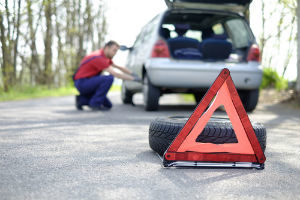Car Emergency Kits Are a Must-Have
Rita and Al Chretien were headed from their home in British Columbia to a trade show in Las Vegas when their van got stuck on a muddy back road in snowy, mountainous Elko County, Nev. It was March 2011. Three days later, Al left to find help. The 59-year-old never returned. After seven weeks of surviving on fish oil pills, trail mix, and hard candy, Rita, 56, was rescued. On Sept. 29, 2012, hunters found Al’s body – about 6 miles from Mountain City, Nev.
Few people ever would be prepared to tackle a wilderness area in March in a two-wheel-drive Chevrolet Astro van. But even if you aren’t a Boy Scout, “be prepared” is a good motto, and it’s sage advice for all motorists.
Whether you are driving to the corner store for a loaf of bread or through Elko County in March on your way to Vegas, having an emergency kit in the trunk is a good idea. And it could end up being a lifesaver.
What to Keep in a Car Emergency Kit
There are three things that should be in the car whenever it leaves the driveway: spare tire, tire jack, and the owner’s manual. Someday, somewhere, you will have a flat tire. There also is a tool you should carry that most people will never need, one used to cut seat belts and break glass. They make one small enough for a keychain.
If you want more assurance of safety than what will fit on your keychain, carry an emergency kit. You can buy one or make your own. The Department of Homeland Security has compiled a list of what to keep in a car emergency kit:
- Jumper cables
- Flares or reflective triangles to signal your vehicle’s presence
- Flashlights and extra batteries
- First-aid kit
- Nonperishable food such as canned goods and protein-rich food such as nuts and energy bars
- Manual can opener
- Water (DHS recommends a three-day supply, or a gallon a day per person)
- Radio (battery-operated or hand-cranked)
- Cat litter, sand, or pieces of cardboard (to put under tires for traction)
- Shovel
- Ice scraper
- Clothes suitable for climate, including a change of clothing and rain gear
- Blankets or sleeping bags
- Charged cellphone and charger
The Department of Homeland Security also notes that an emergency kit should include baby food and supplies and pet food if needed. And don’t forget special medications and medical gear any passenger might need.
During Legal Emergencies, Turn to The Bob Richardson Law Firm
Our attorneys have spent more than 30 years helping the people of Austin, Waco, and the surrounding Texas communities with their car accident and personal injury claims. If you have been hurt in an auto accident and need help fighting for compensation, contact us today for a free evaluation of your case.


